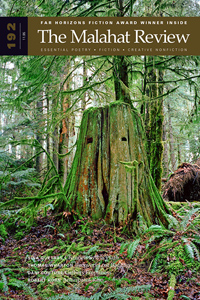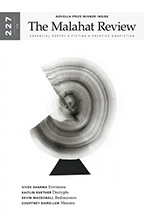Whose Woods These Are: Jay Ruzesky in Conversation with Joe Rosenblatt

This summer, poet Joe Rosenblatt blindfolded Malahat poetry board member Jay Ruzesky and led him into the woods to a secret location to sit on a windfall log, drink herb tea, and talk about the mysteries of the Green Man that are revealed in Rosenblatt’s poems in Issue #192, Autumn 2015.
Is there any connection between the Green Man as represented in medieval architecture and Yoda in George Lucas’ Star Wars?
I suppose in an oblique way there is a connection between Yoda and the Green Man. They are connected in a moral sort of way; the Green Man is the god protector of the forest, fighting forces of evil—Yoda is training the cosmic knight, Luke Skywalker, to fight the evil empire of Darth Vader—a cosmic storm trooper. The Green Man—what to say about him? He is fighting a form of evil on planet earth—let us say the forest companies depleting the old growth giant cedar. Now, the difference is that the Green Man can’t do a damned thing about the profit motive and job creation by the forest companies harvesting trees. We are a resource-based island—and loggers have families to feed and mortgages to pay. All I ask is that those logging companies be mindful of polluting the rivers and creeks that salmon fry run through. Enough said here. I hope I have answered your question. I guess it comes down to an issue of morality, protecting the environment. 
When and how did you get interested in the Green Man? Was there a particular building or sculpture that inspired you?
I spent quite a number of hours sketching trees in the Qualicum Beach Heritage Forest, a nature preserve of forty acres not far from my house. I took hundreds of notations as well as doing sketches of the giant cedar stands—some that are first growth, others second growth, and then it occurred to me that there is a mythic protector of the forest, the ultimate forest manager—the Green Man. Now, I could lie to you and say I met that verdant god quite by accident when I was trekking in the woods on the lookout for a fallen tree to sketch—and the Green Man spoke to me through his floriated mask—and I swore I would never reveal his hideaway—but I would be indulging in mythomania, which poets often do. Suffice it to say that I became the Green Man’s understudy as revealed in the thirty or more Green Man sonnets I have written and in my drawings of the Green Man. In short, the Green Man is my alter ego.
So, last fall on Facebook you posted a photo of yourself sitting on a stump in a green temperate rain forest clearing, but you’re an understudy and not the Green Man yourself?
No, I am not the Green Man and I won’t rat on him, that is, reveal his hiding place in the woods of the Qualicum Beach Heritage Forest. In that photo I was having lunch before I started my sketching. I think the Green Man was amused by my sketching him. I brushed a caterpillar away from his mouth and he was most gratified by my concern for his wellbeing.
The iconography of the Green Man is usually associated with spring and the idea of rebirth. The Green Man figure in your poems seems a little more autumnal than that. Despite the sprouting sword ferns on the nursery log, your green man has seen it all before and seems world-wise and maybe world-weary. How old is your Green Man and what else has he seen?
A very good question indeed. The Green Man is a global traveller. There are so many taverns in rural Britain named after the Green Man, and of course the Green Man is sculptured into the edifices of medieval churches. Imagine how many forests in Britain were depleted to make ships of war—so that the British Empire could rule the waves. Robin Hood, if he ever existed, must be sobbing in his grave. Yes, rebirth, old trees die, decay and their soil composted from the decay of wood gives new life to sprouting, infantile trees in a nurse log—yes, the Green Man as you say has seen it all—the recycling—death, birth, decay—nutrients from a long dead tree feeding a nursery of teensy trees. The iconography is in the structure, in the shape of those trees and fallen trees—and mushrooms feeding off the composting trees. Depending on global warming those musings of mine may seem less autumnal and more inclined to be rather wintry—the rainy season and the like. The Green Man can predate Christianity—going back to the Celts of Europe and certainly to a time when Rome conquered the war-painted warrior of Britain. I would have to say that the Green Man was around in Europe for over a thousand years or more.
The figure of the Green Man has made an appearance in poetry before — from Sir Gawain and the Green Knight to Charles Olson’s poem “The Green Man.” Did any previous works have your attention as you were working on your poems?
Now that you mention Charles Olson and his Green Man poem I daren’t read that poem for fear his poem might be greener than mine. Just kidding here. I haven’t read Olson’s Green Man poem. I should read it. Sir Gawain and the Green Knight, I am familiar with that tale. I should re-read it though. It is good for the soul. Maybe I should get a green outfit when I finally get around to reading my Green Man poems. But sad to say, Olson got there first. Damn!

Jay Ruzesky
* * * * * * * *









